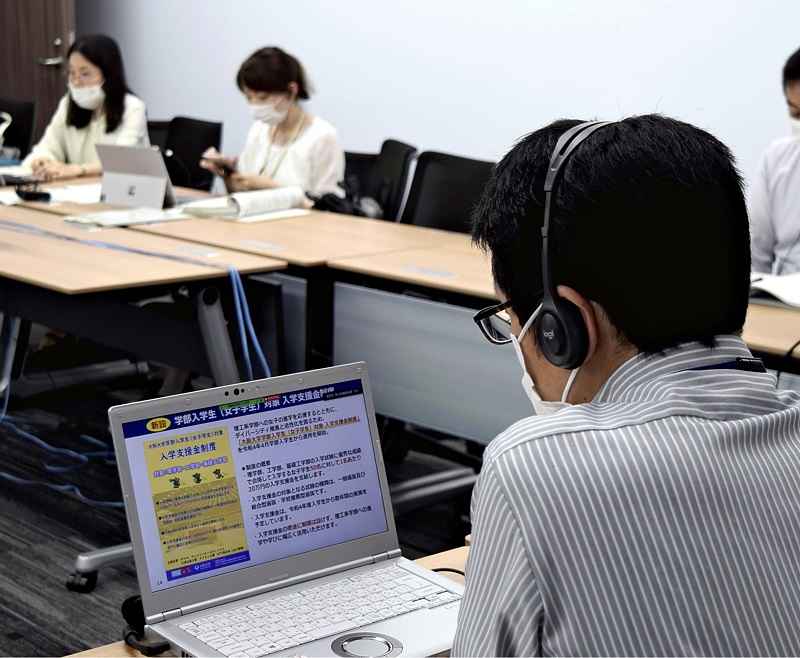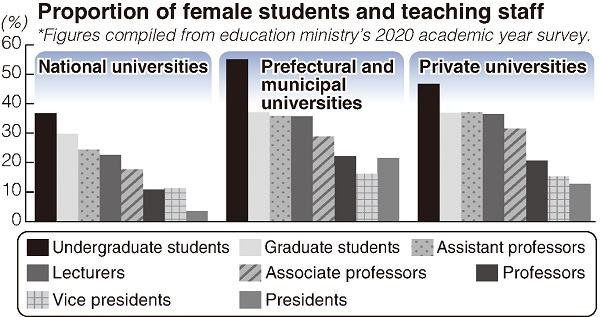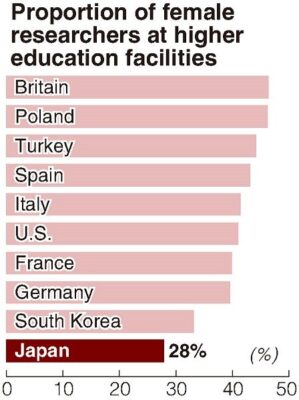
Osaka University officials explain a financial support system during an online event in late June.
10:00 JST, August 17, 2021
OSAKA — National universities in Japan are ramping up efforts to increase their proportion of female teaching staff and students.
Affirmative action policies are also being introduced, with some universities even launching an international teacher recruitment drive limited to female candidates. Gender equality and empowering women is one of the United Nations’ sustainable development goals (SDGs), placing universities under pressure to change and implement reforms that make them a “viable choice” for female students and teachers both in Japan and overseas.
In late June, Osaka University held an online event that introduced female high school students and their parents to the science, engineering, and engineering science undergraduate programs. About 450 people from across Japan joined this “festival for science and engineering girls” to watch and hear explanations on research being done and campus life at the university.
According to a government survey for the 2020 academic year, 37% of students at national universities were female. The figure for Osaka University’s 11 undergraduate schools was 34% as of May. The proportion was especially low — ranging from 9% to 18% — in the science, engineering, and engineering science schools, so the university established a system that will give ¥200,000 each to 50 female students who pass the entrance exams with excellent results. This money will come from corporate donations and reach the students’ pockets from next spring.
“Some parents might worry about their daughter’s future if she wants to study at the science or engineering schools, but universities and companies are eager to attract brilliant women,” said Junko Umeda, an associate professor at the university’s Joining and Welding Research Institute and also in charge of the financial support program. “We want to pique the interest of female students and get more of them applying to enroll.”
Women account for 20% of the university’s teaching staff. More than 50% of students at the School of Letters are female, yet only 20% of the teaching staff there are women. To boost this figure, the school last academic year uncorked an international recruitment drive restricted to female candidates.
Eleven teaching staffers were hired, lifting the proportion of women in these roles to above 30%. Satoshi Nara, a director at the university, said, “We will roll out comprehensive support measures and aim to achieve our current goal of reaching 30% across the whole university.”

An artist illustration : Proportion of female students and teaching staff
Extra incentive
Gender inequality refers to unequal social or cultural treatment or discrimination based on a person’s sex. The SDGs aim to achieve gender equality by 2030, a trend embodied by steps such as having both a male and female flagbearer at the opening ceremony of the Tokyo Olympic Games.
However, Japan still has a lot of catching up to do. In 2018, it was revealed that Tokyo Medical University had been deliberately marking down entrance exam scores of women to restrict the number of female students gaining admission. The Fifth Basic Plan for Gender Equality, which the Cabinet approved at the end of 2020, stated more “positive action” was needed to boost gender equality in education, workplaces and elsewhere.
Since 15 years ago, the Education, Culture, Sports, Science and Technology Ministry has provided support for female researchers. However, just 28% of university-affiliated researchers are women, according to a 2020 government survey on science and technology research. This is below the figure for other nations, based on data from sources including the Organization for Economic Cooperation and Development. According to a government survey conducted during the 2020 academic year, 18% of national university teaching staffers are women, a figure eclipsed by private universities and prefectural and municipal universities.
An applicant’s expertise must be assessed when hiring teaching staff, so personnel decisions often are made by individual departments inside a university school or faculty. At Nagoya University, a target for the number of female teaching staffers is set for each department. Under a system introduced in 2019, exceeding this number results in the department’s budget from the university getting increased; falling short means the budget will be cut.
“Motivation must be provided for each department to proactively take action,” Nagoya University Vice President Hiroko Tsukamura said. “If women can thrive when they are the right people placed in the right jobs, the university will go from strength to strength.”
Being decision-makers
The proportion of female teaching staffers tends to be lower than that of female students, and the figure slides down further in more senior positions. But this year at the University of Tokyo, women account for half of the eight executive vice presidents who, along with the president, form the board of directors.
As of May, 20% of the university’s students were female, as were 14% of the teaching staff in May last year. Board member Kaori Hayashi, who is in charge of diversity and global affairs, said: “When people from different backgrounds come together, they need to explain things to each other. They learn different perspectives and generating ideas becomes easier. Diversity is essential for lifting research levels and making the campus more vibrant. This university is seeking more women.”
Last year, the University of Tokyo placed 36th among universities from around the world ranked by a British education publication. Topping the rankings was the University of Oxford, which has a female vice chancellor. In addition, in the 2020 school year, 51% of its students and 31% of its teaching staff were women.
“Japanese society still has deep-rooted perceptions on the division of roles by gender, and there also is some bias against entrusting women with positions of responsibility,” said Tohoku University Professor Emeritus Miyoko Tsujimura, who also is a lawyer and gender equality expert. “Universities that make gender equality a reality will promote research from various perspectives and also help nurture young people who will change society.”
A diverse range of people, from Japan and abroad, will coalesce at universities that have already started taking the shape of this new society. That also likely will set the stage for creating new knowledge.

An artist illustration : Proportion of female researchers at higher education facilities.
"Society" POPULAR ARTICLE
-

M4.9 Earthquake Hits Tokyo, Neighboring Prefectures
-

Israeli Tourists Refused Accommodation at Hotel in Japan’s Nagano Pref., Prompting Protest by Israeli Embassy and Probe by Prefecture
-

M7.5 Earthquake Hits Northern Japan; Tsunami Waves Observed in Hokkaido, Aomori and Iwate Prefectures
-

Tsukiji Market Urges Tourists to Avoid Visiting in Year-End
-

High School in Kyoto Says Students Shoplifted during Recent School Trip to Bali, Indonesia
JN ACCESS RANKING
-

Tokyo Economic Security Forum to Hold Inaugural Meeting Amid Tense Global Environment
-

Keidanren Chairman Yoshinobu Tsutsui Visits Kashiwazaki-Kariwa Nuclear Power Plant; Inspects New Emergency Safety System
-

Imports of Rare Earths from China Facing Delays, May Be Caused by Deterioration of Japan-China Relations
-

University of Tokyo Professor Discusses Japanese Economic Security in Interview Ahead of Forum
-

Japan Pulls out of Vietnam Nuclear Project, Complicating Hanoi’s Power Plans























